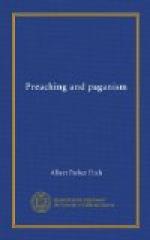Here is where the humanist bids us good-by and we must go forward on our road alone. For he will not acknowledge that there is anything essential or permanent in that divided inner world; he would minimize it or explain it away. But we know it is there and the reason we know there is Something without which can bridge the outer chasm is because we also know there is Something-Else within which might bridge this one. For we who are religious know that within the depths and the immensities of this inner world, where there is no space but where there is infinite largeness, where there is no time but where there is perpetual strife, there is Something-Else as well as the “I” and the “other I,” and it is that He who is the Something-Else who alone can close the gap in that divided kingdom and make us one with ourselves, hence with Himself and hence with His world.
You ask how we can say, “He’s there; He knows.” We answer that this “other,” this “He” is a constant figure in the experience; always in the vision; an integral part of the perception. What is He like? “He” is purity and compassion and inexorableness. Something fixed, immutable, not to be tricked, not to be evaded and oh! all-comprehending. He sees, his eyes run to and fro in all the dark and wide, the light and high dominions of the soul. If we will not come to terms with “Him,” that eternal and changeless life will be the cliff against which the tumultuous waves of the divided spirit shall shatter and dissipate into soundless foam; if we will come to terms, relinquish, accept, surrender, then that purity and that compassion will be the cleansing tide, the healing and restoring flood in which we sink in the ecstasy of self-loss to arise refreshed, radiant, and made whole.
So we reckon from within out. The religious view of the world is based upon the religious experience of the soul. We have no other means of getting at reality. I know that there is Something-more than me and Something-more than the nature outside of me, because we know that there is Something which is not me and is not nature, inside of me. So the man of religion, like any other poet, artist, seer, looks in his own heart and writes. What he finds there is real, or else, as far as he is concerned, there is no reality. He does not assert that this reality is the final and utter truth. But he knows it is his trustworthy mediator of that truth.
Here, then, is an immense separation between religionist and both humanist and naturalist; a separation so complete as to come full circle. We are convinced of the secondary value, both of natural appearances and of the mortal, temporal consciousness. So we substitute for impertinent familiarity with Nature, a reverent regard for what she half reveals, half hides. We interpret her by ourselves. We are the same compound of identity and difference. We acknowledge our continuity with the natural world, our intimate and tragic alliance with the dust, but we also know that we, within ourselves, are Something-Else as well. And it is that Something-Else in us which makes the significant part of us, which sets our value and place in the scale of being.




